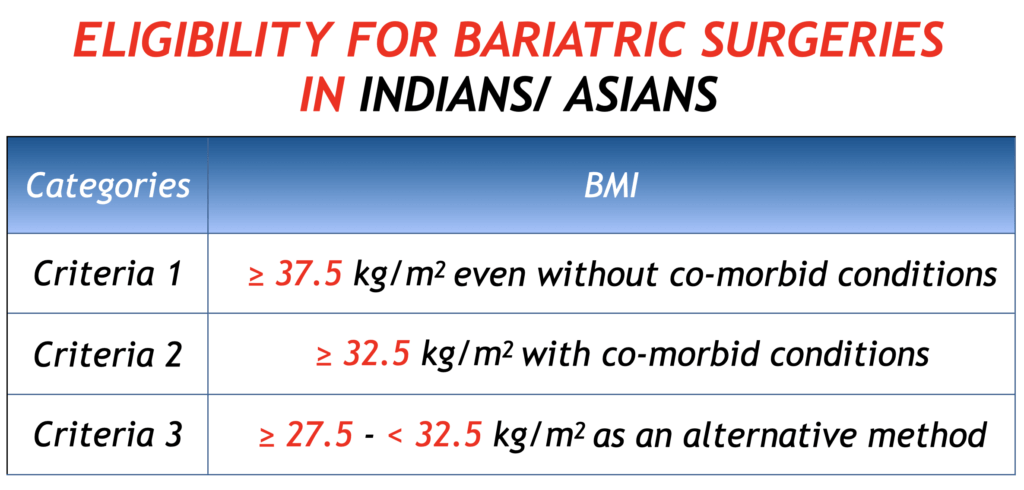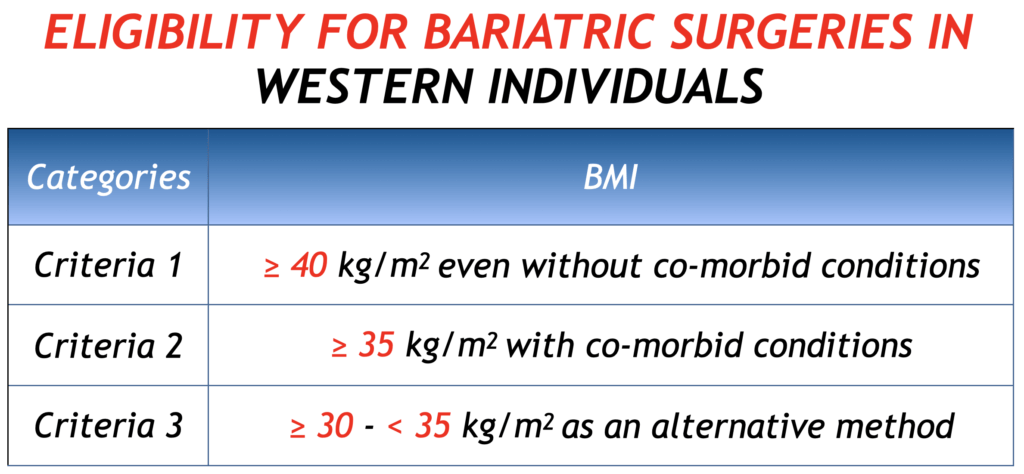Bariatric surgery
(OBESITY SURGERY)
Bariatric surgery is scientifically proven, very safe method for long lasting and effective weight loss. Mechanism of weight loss after bariatric surgery is different from other methods. Sleeve gastrectomy and diversion procedures reset ‘fat set point’ to a lower level by altering several hormones and genes controlling ‘fat mass’.
These are performed on stomach and intestine by laparoscopic method (by putting small holes on tummy). Bariatric and metabolic surgeries are essentially same. If the purpose of surgery is weight loss, then it is called bariatric surgery. If the purpose of surgery is remission from diabetes and other co-morbid medical conditions, it is called metabolic surgery.
Majority of the obese individuals fail to lose weight by diet restriction and regular exercise. Even if they lose initially, weight is regained due to the effect of fat set point. These are benefited from bariatric surgery.
– Bariatric surgery is scientifically proven, very safe method for long lasting and significant weight loss.
– Mechanism of weight loss after bariatric surgery is different from other methods.
– Sleeve gastrectomy, Gastric bypass, and Sleeve plus bypass combination surgeries re-set ‘fat mass’ to a lower level by inducing physiological changes altering body energy balance.
– These are performed on stomach and intestine by laparoscopic method (by putting small holes on the tummy).
– Bariatric and metabolic surgeries are essentially same. If the purpose of surgery is weight loss, then it is called bariatric surgery. If the purpose of surgery is remission from type 2 diabetes and other co-morbid medical conditions, it is called metabolic surgery.
– Majority of the individuals suffering from obesity fail to lose weight by diet control and regular exercise. Even if they lose initially, weight is regained due to the effect of factors controlling body fat mass. Bariatric surgery helps these individuals to achieve their weight loss goals.
– People think that weight loss after bariatric surgeries is mainly due to food restriction and malabsorption. But it is not true.
– Weight loss is mainly due to physiological changes altering body energy balance.
– These alterations include increased Incretins (GLP 1, Peptide YY), reduced Anti-Incretins & Ghrelin.
– Because of these changes
- Appetite (Hunger) is reduced.
- Metabolic rate is increased.
- Energy expenditure is increased.
- ‘Fat mass’ is reset to a lower level.
- Fat starts melting as body doesn’t want to store large quantity of fat.
- You don’t eat large quantity of food as you start hating unhealthy foods.
– Role of food restriction and malabsorption is secondary.
– Same physiological changes are responsible for type 2 diabetes remission.
- Insulin resistance is reduced.
- Insulin production is optimised to control blood sugars.
– Individuals meeting following criteria are eligible for bariatric surgery.
– If you are an Indian/ Asian,
- Your BMI is ≥ 32.5 kg/m2 and you have at least one medical co-morbid condition
- Your BMI is ≥ 37.5 kg/m2 even if you don’t have any medical co-morbid conditions
- Your BMI is ≥ 27.5 kg/m2 but < 30 kg/m2, and you failed to lose weight with lifestyle modifications.
– If you are a foreign national,
- Your BMI is ≥ 35 kg/m2 and you have at least one medical co-morbid condition
- Your BMI is ≥ 40 kg/m2 even if you don’t have any medical co-morbid conditions
- Your BMI is ≥ 30 kg/m2 but < 35 kg/m2, and you failed to lose weight with lifestyle modifications.
– Higher BMI increases the risk of obesity related medical problems.
– If these BMI categories are strictly applied to decide eligibility for bariatric surgery, then many individuals will have no effective therapeutic options left for weight loss.
– As bariatric surgery is very safe and effective, generally 30 kg/m2 is taken as a cut off limit for bariatric surgery in India, regardless of associated medical problems.
– The most popular bariatric surgeries are
- Sleeve gastrectomy (SG),
- Roux-en-y gastric bypass (RYGB) and
- Mini gastric bypass – One anastomosis gastric bypass (MGB – OAGB).
– But these popular surgeries have certain limitations.
– Bilio-pancreatic diversion with duodenal switch (BPD DS) is the most effective bariatric surgery since physiological changes are very high, but malabsorption risk is also very high since most of the small intestine is bypassed.
– There are several modifications of BPD DS to reduce malabsorption without compromising on efficacy. BPD DS and its modifications are known as Sleeve plus procedures or Sleeve plus bypass combination procedures. These modifications include
- Sleeve with loop duodenal switch (SLDS), also known as Single anastomosis duodenoileal bypass with sleeve (SADI S),
- Sleeve gastrectomy with loop gastroileal bypass (SG LGIB), also known as Single anastomosis sleeve ileal bypass (SASI Bypass)
- Sleeve gastrectomy with loop duodeno-jejunal bypass (SG LDJB).
- Sleeve gastrectomy with loop gastrojejunal bypass (SG LGJB), also known as Single anastomosis sleeve jejunal bypass (SASJ Bypass)
- Sleeve gastrectomy with proximal jejunal bypass (SG PJB)
- Sleeve gastrectomy with jejunoileal anastomosis (SG JIA)
- Sleevee gastrectomy with duodenojejunal bypass (SG DJB)
- Sleeve gastrectomy with transit bipartition (SG TB)
- Sleeve gastrectomy with duodenoileal interposition (SG DII), also known as Diverted sleeve gastrectomy with ileal interposition (DSG II)
- Sleeve gastrectomy with jejunoileal interposition (SG JII), also known as Sleeve gastrectomy with ileal interposition (SG II)
– Adjustable gastric banding (LAGB), Greater curve plication (GCP) were once popular, but got out dated because of poor results.
– There are few endoscopic weight loss procedures. These include
- Endoscopic sleeve gastroplasty (ESG)
- Intragastric balloon (IGB)
- Swallowable gastric balloon (SGB)
– Intra gastric balloon (IGB), and Swallowable gastric balloon (SGB) are less effective compared to bariatric surgeries for weight loss because these endoscopic procedures act mainly be food restriction. Physiological changes after these procedures are negligible. Chances of weight regain are very high once balloon is removed. They have a role in well motivated individuals with mild obesity.
– Endoscopic sleeve gastroplasty (ESG) is better intra gastric balloon or swallowable gastric balloon as there are some physiological changes after ESG, but these changes are less than those after bariatric surgeries. Chances of weight regain are high once stomach expands after ESG especially if life style modifications are not followed. ESG has a role in those individuals who have 10 to 20 kg excess weight and in those who are afraid of bariatric surgeries.
– Bariatric surgeries are very safe and highly effective if they are performed on right candidate by qualified surgeons.
– Major complications like bleeding, leak, blood clots in legs are very rare (< 1%).
– Bleeding, leak from staple lines are very rare problems because of usage of high end staplers, guns and vessel sealers. Even if they occur, they can be rectified.
– To prevent blood clots in the legs, you will be prescribed anticoagulant medications.
– Hair loss can occur because of weight loss but this is temporary. Once weight is stabilized all the lost hair will come back.
– Skin loosening can occur because of weight loss but this is temporary. Weight loss is fast and skin tightening is slow. So you may look weak and skin looks wrinkled during weight loss period. Once weight loss stops and weight is stabilised, skin becomes tight and match weight loss in majority of individuals.
– Because of weight loss, people can develop gall bladder stones. Urspdeoxycholic Acid tablets for 1 to 1.5 years are needed to prevent formation of stones in gall bladder during weight loss period.
– To prevent vitamin, mineral and protein deficiencies, you will be prescribed post bariatric multivitamin, mineral and protein supplements.
– You will have food aversions, which will settle over a period of time.
– Individuals eligible for metabolic and bariatric surgeries are fully evaluated by a dedicated team comprising of expert metabolic & bariatric surgeon, dietician, endocrinologist, physician, cardiologist, pulmonologist, sleep apnea specialist, psychiatrist and psychologist. This is to perform surgery at maximum safety and minimize risks near to zero.
– Patients are counselled well about various surgeries, pre & post operative requirements.
– Operation suites for these surgeries are designed at international standards, equipped with high end technology including full HD laparoscopic systems, advanced vessel sealing devices to perform complex bariatric and metabolic surgeries.
– Advanced surgical ICU facilities and 24 hr intensive care specialists coverage ensures maximum safety.
– Dr. Amar performed ‘Sleeve gastrectomy’ surgery on his father Dr. V. Brahma Reddy in Jan 2014. He lost 34 kg and leading a diabetes free life. His HbA1C reduced from 9.2% to 5.7%.
– Dr. Amar also performed ‘Sleeve gastrectomy with duodenoileal interposition’ surgery on his brother-in-law Mr. Srinivasa Reddy in Mar 2013 for uncontrolled diabetes. He lost 23 kg and his sugars are under control even without medications. His HbA1C reduced from 9.6% to 5%.
– He also performed ‘Sleeve gastrectomy with loop gastroileal bypass’ surgery on his mother-in-law Mrs. Vijaya Lakshmi in Aug 2016 for obesity and diabetes. She lost 31 kg and leading healthy active life without diabetes. Her HbA1C reduced from 7% to 4.4%.
– Sleeve gastrectomy (SG) and gastric bypass (RYGB, MGB – OAGB) are most commonly performed obesity surgeries worldwide.
– In most individuals, weight loss is long lasting after SG, RYGB and MGB – OAGB surgeries.
– But some individuals regain lost weight, even after properly performed surgery. This is due to body adaptation to the physiological changes or not sticking to lifestyle modifications.
– When anyone regains weight after bariatric surgery, first they will be advised to change their life style. Some require adjuvant therapy in the form of adding medications
– If lifestyle modifications and medications fail, then these individuals need revision surgery in the form of adding ‘ileal diversion’. This is necessary to restore significant physiological changes needed to induce weight loss again.
– Examples include
- Duodenal switch (DS), ’
- Loop duodenal switch (LDS) or Single anastomosis duodenoileal bypass’ (SADI)
and
- Loop gastroileal bypass (LGIB).
– Individuals with inadequate weight loss after first surgery, also benefit with revision surgery.
– Mr. Srinadh used to weigh 147 kg. He underwent sleeve gastrectomy elsewhere in 2009. He lost 25 kg. But regained even more weight and reached 164 kg. In Mar 2016, Dr. Amar performed revision bariatric surgery, laparoscopic single anastomosis duodenoileal Bypass (SADI) on him. He is now 76 kg. He is happy, healthy and fit.
– Sleeve gastrectomy (SG) and gastric bypass (RYGB, MGB – OAGB) are most commonly performed obesity surgeries worldwide.
– In most individuals, weight loss is long lasting after SG, RYGB and MGB – OAGB surgeries.
– But some individuals regain lost weight, even after properly performed surgery. This is due to body adaptation to the physiological changes or not sticking to lifestyle modifications.
– When anyone regains weight after bariatric surgery, first they will be advised to change their life style. Some require adjuvant therapy in the form of adding medications
– If lifestyle modifications and medications fail, then these individuals need revision surgery in the form of adding ‘ileal diversion’. This is necessary to restore significant physiological changes needed to induce weight loss again.
– Examples include
- Duodenal switch (DS), ’
- Loop duodenal switch (LDS) or Single anastomosis duodenoileal bypass’ (SADI)
and
- Loop gastroileal bypass (LGIB).
– Individuals with inadequate weight loss after first surgery, also benefit with revision surgery.
– Mr. Srinadh used to weigh 147 kg. He underwent sleeve gastrectomy elsewhere in 2009. He lost 25 kg. But regained even more weight and reached 164 kg. In Mar 2016, Dr. Amar performed revision bariatric surgery, laparoscopic single anastomosis duodenoileal Bypass (SADI) on him. He is now 76 kg. He is happy, healthy and fit.
– Bariatric and metabolic surgeries are performed in individuals between 18 and 65 years age.
– Surgeries can be considered in those below 18 years, if all other methods failed to induce weight loss.
– Surgeries can also be considered in selected individuals above 65 years, if their general condition allow them to undergo surgery.



